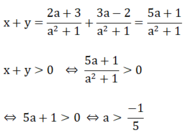Hãy nhập câu hỏi của bạn vào đây, nếu là tài khoản VIP, bạn sẽ được ưu tiên trả lời.

a: \(\Leftrightarrow\left\{{}\begin{matrix}x-\dfrac{1}{2}y=2\\\dfrac{3}{2}x-y=\dfrac{3}{2}\end{matrix}\right.\Leftrightarrow\left\{{}\begin{matrix}2x-y=4\\3x-2y=3\end{matrix}\right.\Leftrightarrow\left\{{}\begin{matrix}4x-2y=8\\3x-2y=3\end{matrix}\right.\)
\(\Leftrightarrow\left\{{}\begin{matrix}x=5\\2x-y=4\end{matrix}\right.\Leftrightarrow\left\{{}\begin{matrix}x=5\\y=2x-4=6\end{matrix}\right.\)

a: Thay m=1 vào hệ phương trình, ta được:
\(\left\{{}\begin{matrix}x-y=1\\2x+y=4\end{matrix}\right.\)
=>\(\left\{{}\begin{matrix}3x=5\\x-y=1\end{matrix}\right.\Leftrightarrow\left\{{}\begin{matrix}x=\dfrac{5}{3}\\y=x-1=\dfrac{5}{3}-1=\dfrac{2}{3}\end{matrix}\right.\)
b: Để hệ có nghiệm duy nhất thì \(\dfrac{m}{2}\ne-\dfrac{1}{m}\)
=>\(m^2\ne-2\)(luôn đúng)
\(\left\{{}\begin{matrix}mx-y=1\\2x+my=4\end{matrix}\right.\)
=>\(\left\{{}\begin{matrix}y=mx-1\\2x+m\left(mx-1\right)=4\end{matrix}\right.\)
=>\(\left\{{}\begin{matrix}y=mx-1\\x\left(m^2+2\right)=m+4\end{matrix}\right.\)
=>\(\left\{{}\begin{matrix}x=\dfrac{m+4}{m^2+2}\\y=\dfrac{m\left(m+4\right)}{m^2+2}-1=\dfrac{m^2+4m-m^2-2}{m^2+2}=\dfrac{4m-2}{m^2+2}\end{matrix}\right.\)
x+y=2
=>\(\dfrac{m+4+4m-2}{m^2+2}=2\)
=>\(2m^2+4=5m+2\)
=>\(2m^2-5m+2=0\)
=>(2m-1)(m-2)=0
=>\(\left[{}\begin{matrix}2m-1=0\\m-2=0\end{matrix}\right.\)
=>\(\left[{}\begin{matrix}m=\dfrac{1}{2}\\m=2\end{matrix}\right.\)


Do a 2 + 1 ≠ 0 ∀ x nên hệ phương trình trở thành:

Khi đó:

Vậy với a > (-1)/5 thì hệ phương trình có nghiệm duy nhất (x; y) thỏa mãn x+y >0